VineBalance Sustainable Viticulture Program
Welcome to VineBalance
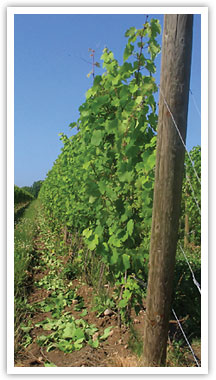 VineBalance is a joint effort by the wine and juice grape industry, Cornell Cooperative Extension, and the New York Department of Agriculture and Market’s Soil and Water Conservation Committee to define and promote the use of sustainable growing practices on the 33,000 acres of vineyards in New York.
VineBalance is a joint effort by the wine and juice grape industry, Cornell Cooperative Extension, and the New York Department of Agriculture and Market’s Soil and Water Conservation Committee to define and promote the use of sustainable growing practices on the 33,000 acres of vineyards in New York.
The program’s major goals are to promote and document grape production practices that:
- Protect the environment (specifically water quality and soil health)
- Protect the health of workers, neighbors, and consumers
- Increase or maintain the profitability of grape production.
The foundation of the program is our grower self-assessment workbook. Designed to both document sustainable grape growing practices already in place and promote sustainable practices throughout the industry, the workbook is primarily an educational tool to bring awareness to the economic, environmental and social implications of specific viticultural practices. The self-assessment provides a baseline for potential modifications detailed in an action plan drawn up after completing the workbook.
The potential benefits to participating growers include:
- Eligibility for cost-sharing opportunities for farm improvements through state and federal conservation agencies
- Increased product marketability for the grapes and grape products produced through sustainable means
- Economic and environmental savings through efficient use of fertilizers and agrichemicals
- Improved neighbor relations and industry reputation.
Grape production is a high-profile agricultural enterprise. By making it an industry-wide goal to produce grapes, juice, and wine using sustainable practices, participating growers will help themselves and the state by reducing environmental risks and ensuring a healthy future for New York’s grape growing industry.
What is Sustainable Viticulture?
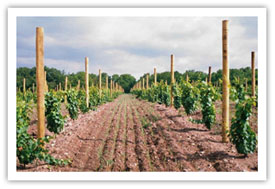 Sustainable agriculture attempts to minimize environmental impacts and ensure economic viability and a safe, healthy workplace through the use of environmentally and economically sound production practices. Growers make a multitude of choices regarding the practices they use to manage vine growth, weeds, diseases, insects, and soil fertility. The level of sustainability is the sum of these decisions that growers make in the course of producing their crop.
Sustainable agriculture attempts to minimize environmental impacts and ensure economic viability and a safe, healthy workplace through the use of environmentally and economically sound production practices. Growers make a multitude of choices regarding the practices they use to manage vine growth, weeds, diseases, insects, and soil fertility. The level of sustainability is the sum of these decisions that growers make in the course of producing their crop.
We choose to define our program as a process by which growers can evaluate their whole range of production practices and decide how and when to adopt specific practices that increase the sustainability of their vineyards. Growing conditions vary each year, and all growers work under a set of managerial and financial constraints unique to their vineyards.
VineBalance is not an organic viticulture program with a defined set of allowable and unallowable inputs. Rather, the program addresses how all of the potential production practices impact the environmental, economic and social outcomes on the farm and how best to maximize the benefits associated with these outcomes through sound growing practices.
Promoted Practices
 VineBalance promotes the adoption of best management practices that increase the sustainability of grape production throughout the state.
VineBalance promotes the adoption of best management practices that increase the sustainability of grape production throughout the state.
New York’s cool-climate viticulture faces a diversity of challenges including variations in soil type, winter weather, disease and pest pressures, and varieties grown. Each production region is unique: Long Island is characterized by sandy soils, mild winters and exclusively vinifera varieties; the Lake Erie Region possesses gravelly loam and clay soils and primarily bulk juice and wine grapes; and the Finger Lakes Region has a mix of native, hybrid and vinifera varieties grown predominantly in clay and gravel soils along the steep slopes of the lakes.
VineBalance addresses this diversity through its 134-question grower self-assessment workbook and subsequent action plan development. The main issues covered include:
- Soil management to reduce erosion, runoff and leaching and improve soil health
- Integrated pest management (IPM) techniques for insect, disease and weed control
- Nutrient management with a particular focus on nitrogen
- Pesticide storage and handling and modern spray technologies
- Vineyard floor management including cover crops and water use
- Canopy management techniques to enhance fruit quality and reduce disease pressure
More specifically, the program promotes individual practices such as:
Soils and Nutrients
- Pre-plant soil analysis and amendments (nutrients, organic matter, compaction, drainage, pH)
- Soil and water conservation structures (diversion ditches, buffer strips)
- Tile drainage
- Organic matter additions
- Regular soil and tissue sampling
- Efficient nitrogen use and timing of nutrient applications
- Safe and secure storage of fertilizers
Vineyard Floor and Water Management
- Mulching for water retention, organic matter, and erosion prevention
- Seeded cover crops and maintaining permanent cover between rows
- Hilling up vines to prevent winter injury
- Efficient irrigation
- Non-chemical and post-emergent weed management techniques
- Weed mapping to highlight problem areas and species
Viticulture/Canopy Management
- Selecting appropriate varieties and rootstocks
- Selecting appropriate training systems for the site and variety/rootstock
- Estimating and modifying yield through pruning and shoot and cluster thinning
- Increasing air flow and spray penetration into the canopy (managing vigor, leaf pulling, hedging)
- Optimal timing of canopy management for vinifera varieties especially
Integrated Pest Management
- Fruit exposure for reduced disease pressure
- Scouting for insects and diseases
- Utilizing thresholds for efficient pest management
- Selecting reduced risk pesticides
- Spot treatment of pests
- Critical fungicide spray timing (pre-bloom and post-bloom)
- Rotating agrichemicals to prevent resistance
Pesticide Management
- Safe and secure pesticide storage
- Tailor sprayer settings to canopy development stage
- Choosing equipment and practices that reduce spray drift and increase deposition
- Improving pesticide mixing and loading facilities
About Vinebalance
Program History
 In 2004, industry groups from throughout the state asked regional Cooperative Extension grape programs to develop an outreach and education program to promote the adoption of sustainable viticultural practices in New York vineyards. New York State’s sustainable viticulture program is a cooperative effort between industry groups, the Finger Lakes Grape Program, Lake Erie Regional Grape Program and Long Island’s grape extension program. It is designed to both document sustainable grape growing practices already in place and promote sustainable practices throughout the industry. The foundation of the program is its grower self-assessment workbook – 134 questions in 8 sections covering the multitude of management decisions made by New York State grape growers.
In 2004, industry groups from throughout the state asked regional Cooperative Extension grape programs to develop an outreach and education program to promote the adoption of sustainable viticultural practices in New York vineyards. New York State’s sustainable viticulture program is a cooperative effort between industry groups, the Finger Lakes Grape Program, Lake Erie Regional Grape Program and Long Island’s grape extension program. It is designed to both document sustainable grape growing practices already in place and promote sustainable practices throughout the industry. The foundation of the program is its grower self-assessment workbook – 134 questions in 8 sections covering the multitude of management decisions made by New York State grape growers.
 The workbook sections evolved from materials of two earlier programs in New York: NYS Agricultural Environmental Management (AEM) worksheets and the Long Island Sustainable Practices Workbook. Throughout the winter of 2005-2006, a steering committee composed of extension, research, industry and grower representatives (from National Grape Cooperative, Centerra Wine Co., and Finger Lakes and Long Island vineyards), reviewed and developed questions that encompass the practices used in the varied growing regions of New York. The workbook acts as a roadmap for evaluating viticultural practices, addressing the diversity of the state’s grape growing industry with a broad range of questions.
The workbook sections evolved from materials of two earlier programs in New York: NYS Agricultural Environmental Management (AEM) worksheets and the Long Island Sustainable Practices Workbook. Throughout the winter of 2005-2006, a steering committee composed of extension, research, industry and grower representatives (from National Grape Cooperative, Centerra Wine Co., and Finger Lakes and Long Island vineyards), reviewed and developed questions that encompass the practices used in the varied growing regions of New York. The workbook acts as a roadmap for evaluating viticultural practices, addressing the diversity of the state’s grape growing industry with a broad range of questions.
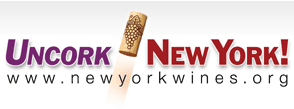 During the summer and fall of 2006, five growers from each of the three cooperative program areas volunteered to field-test the workbook and provide feedback on possible improvements with the content, format and style of the first draft. Final revisions were made, and in 2007, VineBalance’s New York Guide to Sustainable Viticulture Practices Grower Self-assessment Workbook was published.
During the summer and fall of 2006, five growers from each of the three cooperative program areas volunteered to field-test the workbook and provide feedback on possible improvements with the content, format and style of the first draft. Final revisions were made, and in 2007, VineBalance’s New York Guide to Sustainable Viticulture Practices Grower Self-assessment Workbook was published.
Development of the workbook was funded by grants from:
- Northeast Center for Risk Management Education
- New York Farm Viability Institute
- Lake Erie Regional Grape Program, Inc.
- New York Wine and Grape Foundation
Continued outreach has been funded through a grant from the New York Farm Viability Institute.

VineBalance's Link to AEM
 New York’s Agricultural Environmental Management (AEM) Program is a voluntary, incentive-based program that helps farm operators make common-sense, cost-effective and science-based decisions that help meet business objectives while protecting and conserving the State’s natural resources. Strong partnerships at the local, state and federal levels have led to the growing success of AEM, linking existing agricultural and natural resource service agencies together with the farmer as a cooperative team. As the umbrella program for all of New York’s agricultural conservation efforts, AEM also lays the groundwork for participation in other state, federal and locally administered programs. With close to 10,000 farms enrolled in 54 counties across the state, AEM is continually expanding as new assessment tools are tailored to meet the needs of all types and sizes of agricultural operations.
New York’s Agricultural Environmental Management (AEM) Program is a voluntary, incentive-based program that helps farm operators make common-sense, cost-effective and science-based decisions that help meet business objectives while protecting and conserving the State’s natural resources. Strong partnerships at the local, state and federal levels have led to the growing success of AEM, linking existing agricultural and natural resource service agencies together with the farmer as a cooperative team. As the umbrella program for all of New York’s agricultural conservation efforts, AEM also lays the groundwork for participation in other state, federal and locally administered programs. With close to 10,000 farms enrolled in 54 counties across the state, AEM is continually expanding as new assessment tools are tailored to meet the needs of all types and sizes of agricultural operations.
VineBalance’s New York Guide to Sustainable Viticulture Practices Grower Self-assessment Workbook is recognized and endorsed by the AEM Program of the New York State Soil & Water Conservation Committee and New York State Department of Agriculture & Markets as the official Tier 2 Assessment Worksheets for vineyards.
For more information about the AEM Program, visit their website at: www.agmkt.state.ny.us/soilwater/aem
Grower Self-assessment Workbook
About the workbook
 The New York Guide to Sustainable Viticulture Practices Grower Self-assessment Workbook is designed to both document sustainable grape growing practices already in place and promote sustainable practices throughout the industry. The workbook addresses specific production practices growers use to manage soil resources, vine growth, and vineyard pests to educate them about sustainable options for accomplishing these tasks. By comparing their current practices with examples provided in the workbook, growers can both assess and discover ways to improve their sustainability. The self-assessment from the grower provides a baseline for modifications detailed in an action plan drawn up after completing the workbook.
The New York Guide to Sustainable Viticulture Practices Grower Self-assessment Workbook is designed to both document sustainable grape growing practices already in place and promote sustainable practices throughout the industry. The workbook addresses specific production practices growers use to manage soil resources, vine growth, and vineyard pests to educate them about sustainable options for accomplishing these tasks. By comparing their current practices with examples provided in the workbook, growers can both assess and discover ways to improve their sustainability. The self-assessment from the grower provides a baseline for modifications detailed in an action plan drawn up after completing the workbook.
Please note that this workbook is not a production guide. Managing vineyards is a complex enterprise involving numerous site and variety-specific practices and weather conditions, along with skill and experience in making decisions. Not all questions will apply to your vineyard, nor are the options listed for management the only possible solutions. You are the person most familiar with your site and most suited to deciding what is applicable to your situation.
How to use the workbook
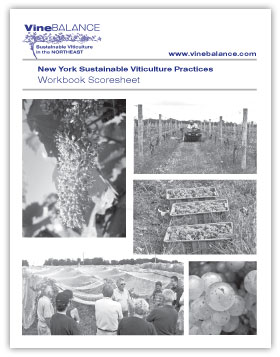 This workbook contains 134 questions in 8 sections. The questions address issues or practices that are important to good vineyard management. Each question is followed by 4 options ordered on a sustainable scale, with “1” being the most desired (i.e. most sustainable) option and “4” being the least. The questions are designed to help you evaluate all areas of your current management practices, with each chapter covering a different production area. A sample question is presented here.
This workbook contains 134 questions in 8 sections. The questions address issues or practices that are important to good vineyard management. Each question is followed by 4 options ordered on a sustainable scale, with “1” being the most desired (i.e. most sustainable) option and “4” being the least. The questions are designed to help you evaluate all areas of your current management practices, with each chapter covering a different production area. A sample question is presented here.
Questions are often followed by a short sidebar designed to further explain the rationale behind the promoted practices and provide additional resources related to the topics. When reading through the possible answer options, we recommend starting at option #4 and moving toward option #1, choosing the option that your current practice fully encompasses. If you find that your present practice comprises part, but not all, of an answer, choose the higher score. For instance, if you presently perform only two of the three practices necessary to assess yourself a score of “2” on a certain question, score yourself a “3” on that question. Your scores will provide a baseline from which to develop an action plan and assess improvement after implementation of your plan. It’s important to note that this is not a test, and there are no wrong answers. Simply choose the answer that best describes what you do. In answering the questions, it may be helpful to think of a particular vineyard block rather than a range of different blocks and varieties. We recognize that different varieties may require different management approaches.
Some of the questions in the workbook may not be applicable to your farm, so you can skip the questions that don’t apply to you and mark ‘NA’ on the score sheet. Canopy management questions applicable to vinifera grapes, for example, will not be applicable to Concord production. Similarly, if you don’t use irrigation, you can skip the irrigation section.
A score sheet is provided for you to record your responses to the questions. Action plan development follows the completion of the self-assessment workbook.
Workbook Sections
The New York Guide to Sustainable Viticulture Practices Grower Self-assessment Workbook is posted here in pdf files.
Introductory Sections – includes the title pages, table of contents, introduction, collaboration with the AEM Program, Steering Committee members, preface, acknowledgments, ‘how to use this workbook’, and an example question.
Soil Management – 25 questions on topics including preplant site preparation (drainage, soil testing, amendments, soil conservation practices), cover crops, organic matter, leaching and runoff.
Nutrition Management – 20 questions on topics including macro- and micronutrient use efficiency (with a concentration on nitrogen) and fertilizer storage.
Vineyard Management – 18 questions on topics including canopy management practices (leading to high quality fruit and reduced disease pressure) and yield management.
Irrigation Management – 8 questions on topics including system design and maintenance and water use efficiency.
Weed Management – 12 questions on topics including post- versus pre-emergent herbicides and herbicide application practices.
Pest Management – 27 questions on topics including scouting, economic thresholds, and adapting disease management programs to variety, climatic conditions and periods of vine susceptibility.
Pesticide Management – 18 questions on topics including the safe mixing, loading and storage of pesticides on the farm.
Continuing Education – 6 questions on topics including participation in meetings and the possession of viticultural reference material.
References – a list of pertinent publications.
Score Sheet – an 8-page score sheet on which to record your self-assessment for each question. Score can also be recorded in the ‘Your Rank’ column next to each question within the sections.
Action Plans
Upon completion of the workbook, the next step is to develop an action plan based on the results of your self-assessment. The plan will address the practices that you believe you can effectively modify within the financial and management capacity of your farm. Concentrate on the issues that you assessed as a ‘three’ or ‘four’, with the goal of reaching the more sustainable ‘one’ or ‘two’ rating for that practice. If there are practices that you assessed a ‘two’ that you feel you can easily climb to a ‘one’, include those as well. The action plan is yours, and only you will know what is practical and possible on your farm.
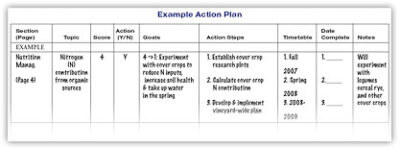
The Action Plan Template includes an example of a practice to be modified. All of the practices that you assessed a ‘three’ or ‘four’ should be listed on the template. For each potential action in your action plan, you must:
- Decide if you want to take action on that specific practice (Action Y/N)
- Determine what you want to do in regard to that action (Goals)
- Organize your steps along the road to adoption of the modified practice (Action Steps)
- Provide a timeline for completion (Timetable).
The template also contains space for the completion dates of your action steps as well as space for any pertinent notes regarding your proposed action. It is important that your action plan details all of this information in order to fulfill the requirements for potential cost-sharing opportunities with your Soil and Water Conservation District (SWCD) and Natural Resources Conservation Service (NRCS) offices. The second page of the action plan template is left blank and can be photocopied as necessary to include all of the practices that you assessed a ‘three’ or ‘four’.
Extension personnel from your regional grape program can provide assistance, and your local SWCD office is equipped to aid action plan development and educate you on possible cost-sharing opportunities for actions in your plan. After you have completed the workbook and are prepared to construct an action plan, contact your grape and SWCD programs to take advantage of the guidance available to you.
Sustainable Viticulture in the Northeast Newsletter
 Complementing the grower self-assessment workbook is an educational newsletter, Sustainable Viticulture in the Northeast. It provides an in-depth examination of the economic, environmental and social implications of specific practices and includes interviews with growers who have put the principles described in the newsletter into practice on their farms.
Complementing the grower self-assessment workbook is an educational newsletter, Sustainable Viticulture in the Northeast. It provides an in-depth examination of the economic, environmental and social implications of specific practices and includes interviews with growers who have put the principles described in the newsletter into practice on their farms.
Grower Participation
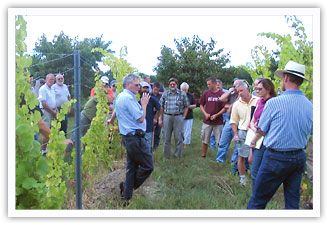 As of early June 2008, 75 growers have completed the self-assessment workbook through our outreach, and an additional 22 have purchased the workbook on their own.
As of early June 2008, 75 growers have completed the self-assessment workbook through our outreach, and an additional 22 have purchased the workbook on their own.
The 75 growers manage a total of 6,560 acres.
By region, the 75 growers include:
- 32 in the Finger Lakes Region (2,156 acres),
- 27 in the Lake Erie Region (3,854 acres),
- 10 from Long Island (499 acres), and
- 6 from the Hudson Valley (51 acres).
Twenty-three of the 75 participating growers have developed an action plan, and these action plans detail a total of 445 specific proposed practice modifications (about 13 per action plan). These practice modifications include:
- the safe storage and handling of fertilizers and pesticides (33% of the practices listed in their action plans),
- monitoring and improving soil health (17%), and
- increasing spray deposition and reducing drift (5%).
Forty-eight of the 445 proposed actions have been complete by the growers, and this number should steadily increase as growers reach and pass the one year post-action plan development mark.
Our goal for 2008 is to have 100 growers participating in VineBalance by the end of the year.